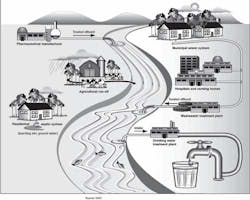Testing data shows breakthrough in treatment for micropollutants in municipal wastewater
WESTMINSTER, CA, JAN 10, 2019 -- BioLargo, Inc. (OTCQB:BLGO), developer of sustainable science and technologies and a full-service environmental engineering company, has announced the completion of a third-party study indicating the company's Advanced Oxidation System (AOS) water treatment technology can eliminate certain toxic micropollutant contaminants associated with municipal wastewater
Micropollutants are widespread and persistent contaminants of significant concern to regulators due to environmental and human health concerns, and are difficult to treat using conventional wastewater treatment technologies (such as UV and biological treatment). Consequently, discharge of micropollutants in municipal wastewater effluents is currently a high priority issue for regulators and municipalities. Due to the lack of existing economically viable solutions for the elimination of micropollutants from municipal wastewater, these findings make the AOS a breakthrough in advanced municipal wastewater treatment.
BioLargo had previously reported on a third-party study conducted in collaboration with researchers at the Centre Des Technologies de L'Eau suggesting its AOS technology effectively removes certain pharmaceutical by-products (i.e., micropollutants) from water.
In this follow-up study conducted by Dr. Greg Goss, an expert in aquatic toxicology at the University of Alberta, in collaboration with BioLargo's Canadian subsidiary BioLargo Water, Inc., Dr. Goss examined the environmental safety of AOS-treated municipal wastewater to demonstrate it did not produce toxic by-products, and whether the AOS' ability to eliminate pharmaceuticals from water would improve the environmental safety and water quality of municipal wastewater "spiked" with high concentrations of micropollutant contaminants of particular concern to regulators.
This study succeeded on both fronts, demonstrating that water treated by the AOS technology was non-toxic to certain aquatic organisms typically used for testing whole effluent toxicity for the EPA's National Pollutant Discharge Elimination System (NPDES) Permits Program, such as Daphnia and rainbow trout, as well as zebrafish embryos. Additionally, the AOS eliminated biomarker responses of municipal wastewater that has been experimentally contaminated (spiked) with compounds (benzo[a]pyrene and 17β-estradiol) known to negatively affect those organisms.
Further, the study showed that the AOS reduces the well-documented aberrant endocrine disrupting chemical (EDC) effects of 17β-estradiol (an estrogen derivative) on rainbow trout. AOS was able to reduce both the normal EDC effects of municipal wastewater on rainbow trout and was also successful in removing 17β-estradiol from municipal wastewater spiked with much higher levels of the hormone.
These results represent promising evidence that the AOS can remove micropollutants that are an emerging concern to the water treatment industry. Given that micropollutants are bioactive and persistent contaminants that are not removed by traditional wastewater treatment methods, AOS has the potential to fill an important niche treatment gap with growing demand: effective and cost-efficient removal of micropollutants in wastewater treatment.
Dr. Greg Goss commented on the results, "More work is needed, but it appears that the AOS treatment is a major technical breakthrough for the removal of micropollutants from wastewater."
This work was funded in part by the Canadian Natural Science and Engineering Research Council (NSERC) and the National Research Council of Canada Industrial Research Assistance Program (NRC IRAP). Learn more at www.biolargo.com.
